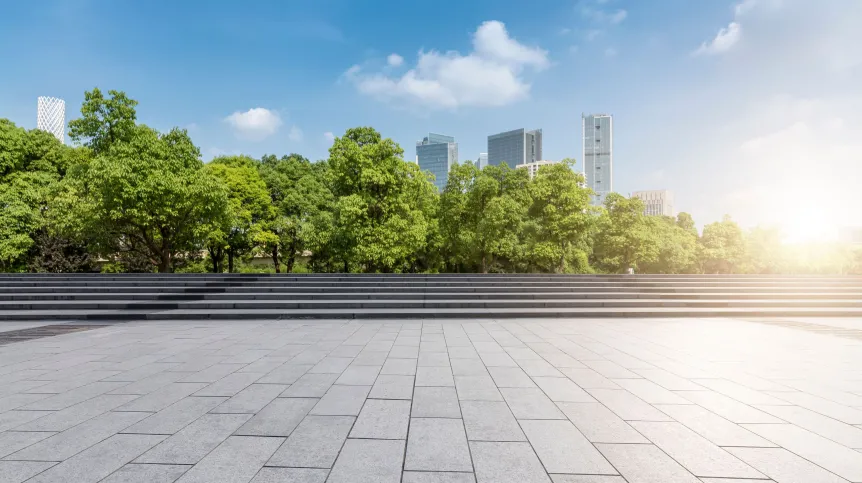
'We need to free our cities of concrete, because it will soon become unbearable,’ says Professor Tomasz Jurczak from the University of Lodz. According to ecohydrologists, this is the last moment to change our way of thinking about water and greenery in cities as critical infrastructure.
Increasing temperatures bother city dwellers the most, while in suburban communes there are increasing shortages of water during hot weather. Add to that drought in the city, flooding after heavy rains - these are difficulties that are getting heavier every year.
Professor Jurczak who is head of the UNESCO Chair on Ecohydrology and Applied Ecology at the Faculty of Biology and Environmental Protection of the University of Lodz said: 'We have been working on it for decades. Already 20 years ago, we saw that winters in our region were becoming less and less snowy. Today, there are only a few days of snow in winter, and there are also periods when there is no snow at all. Why is that so important The snow cover is responsible for replenishing groundwater resources. And those are in shorter and shorter supply.’
Statistics also show that every year there are more and more communes that have problems with providing water to residents. At the beginning of June in some communes there were first requests to reduce the consumption of tap water. Recently, this request was made by Mayor of Dobroń near Lodz.
Professor Jurczak said: 'Small towns functioned for many years and there was no shortage of water, but now more and more people are escaping the cities, building houses in the countryside or spending the entire summer season there, often excessively using water mainly for watering gardens. Pumps designed for, say, two thousand inhabitants, now have to take much more water and it turns out that it is either technically impossible or there is not enough water. Summer is only just beginning, and over 100 communes in Poland are already reporting a problem with the lack of water or its poor quality. In recent years, there were up to 400 such communes per year.’
The scientific journal Geophysical Research has published a paper that shows that the tilt of the planet has changed by 80 cm, which is probably due to the fact that man has extracted more than two thousand gigatons of underground water in the last 20-30 years.
Jurczak said: 'And we extracted it only to discharge it to the sewage system and then to rivers after its one-time use. As a result, the water levels in the seas have risen by 6 mm. Meanwhile, water is a natural resource that rebuilds over hundreds, maybe even thousands of years. By using groundwater resources in an unlimited way, we cause significant losses, disrupting water circulation in nature.’
According to the ecohydrologist, the solution is not to dig deeper and deeper wells to extract water from greater depths, but to educate about the use of water that is available on the surface. However, it is all the more difficult because cities are expanding and at the same time they are more and more concreted.
'A high curb on every street means that instead of going to the ground, water gets into the sewage system and out of the city through pipes. The water flows into straightened, sometimes also concreted rivers and then quickly towards the sea. We are in talks with city and commune authorities to use areas related to urban greenery, mainly in areas of extremely valuable nature, such as river valleys, which, unfortunately, are more and more often built up, to let the rivers spill over there and use this green and blue infrastructure to retain water in the ground and plants,’ says Professor Jurczak.
However, scientists point out that erroneous actions related to the maintenance of rivers - mowing vegetation and deepening river channels - lead to further degradation of these ecosystems. During rainless periods, the lower water level in the rivers also results in a lower groundwater level in the valleys.
According to hydrologists, it is still not too late to fight for water in cities.
'We need to learn to think about water and greenery as critical infrastructure, just like in the case of road or transmission, i.e. power or gas infrastructure. This issue was first raised inNature by Professor Iwona Wagner. Nobody builds a house, office building or housing estate today without taking these utilities into account, so why do we omit greenery and rainwater retention? If we learn to manage water in the city properly, we will avoid not only drought, but also flooding during heavy rainfall, which is also becoming more and more frequent,’ says Jurczak.
Therefore, he adds, already at the stage of planning and designing various investments, the possibility of water retention in the landscape should be taken into account - in the place where it appears, for example as a result of precipitation. An important element is also the availability of biologically active areas capable of collecting this water, as well as the presence of trees, especially large ones, which are already growing in a given area. They provide shade and retain the most water, and allow to lower the temperature by up to 10 degrees Celsius.
'Cutting down adult, large trees for new construction investments and planting new ones in their place, ones that in many cases wither within a short period of time, is not the right approach. Even if these new plantings take hold, it takes at least a dozen or so years for them to provide us with the benefits that adult trees provided,’ says Jurczak.
He adds that local government authorities ask ecohydrologists for help in freeing cities of concrete and, according to their experience, the most critical places are stations, squares, main streets and other places that have been built or thoroughly rebuilt over the last few years.
'Unfortunately, removing concrete from existing infrastructure is much more difficult and much more expensive than planning it properly, e.g. taking into account greenery, at the design stage. Sometimes changes are not possible at all due to the underground infrastructure,’ he explains.
So how can we deal with concrete, lack of greenery and lack of water in cities?
'Cities can +de-concrete+ themselves. We can achieve a satisfactory effect within a dozen or so years, provided, however, that we start introducing changes immediately. It is enough that with each new investment we take into account the possibility of leaving an appropriate biologically active area, covered with multi-species vegetation, an area that will also be used to retain as much rainwater as possible. If we approach each investment in this way, starting from parking lots, street or sidewalk reconstruction, to the construction of new facilities, we can achieve success in a short period of time,’ says Professor Jurczak.
On the one hand, he says, these are often small changes at the level of implemented and planned investments, and on the other hand, it is a huge change in thinking about water and greenery as critical infrastructure. (PAP)
PAP - Science in Poland, Bartłomiej Pawlak
bap/ bar/ kap/
tr. RL













